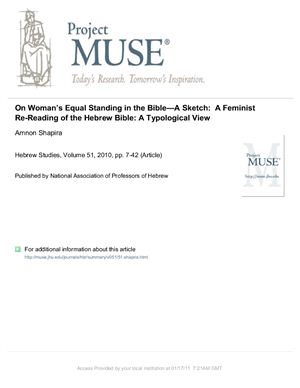Hebrew Studies, Volume 51, 2010, pp. 7-42 (Article)
Published by National Association of Professors of Hebrew
Elizabeth Cady Stanton (1895) is considered the pioneer of feminist literature; after her, in the 1950s, came Simone De Beauvoir (The Second Sex), and the latest crop of feminist writers includes Phyllis Trible, Mieke Bal, Esther Fuchs, Cheryl Exum, Tikva Frymer-Kensky, Ilana Pardes, and many
others. These women deal also with the Bible, as they claim that the female characters, such as Eve and Miriam, have a great influence on the personal and social status of women until today. This is true especially in the Christian world, whose cultural base was the Bible.
The article presents an overview of seven areas in the Bible which point up the equality, and even the superiority, of women, and our conclusions are:
A) The Bible, which is mainly patriarchal, has an additional, parallel direction, in which there is a clear trend of feminine equality;
B) The major equality in the Bible is religious, that is, equality of the woman as a person before God, like the equality of each person within the human race;
C) From this we see that the Jewish religion, as portrayed in the Bible, contains the elements which form the theological and historical base of equality;
D) A possible conclusion from this work is that this feminine side of the Bible, from Sarah and Miriam, may become the base at this time for spiritual renewal.
Published by National Association of Professors of Hebrew
Elizabeth Cady Stanton (1895) is considered the pioneer of feminist literature; after her, in the 1950s, came Simone De Beauvoir (The Second Sex), and the latest crop of feminist writers includes Phyllis Trible, Mieke Bal, Esther Fuchs, Cheryl Exum, Tikva Frymer-Kensky, Ilana Pardes, and many
others. These women deal also with the Bible, as they claim that the female characters, such as Eve and Miriam, have a great influence on the personal and social status of women until today. This is true especially in the Christian world, whose cultural base was the Bible.
The article presents an overview of seven areas in the Bible which point up the equality, and even the superiority, of women, and our conclusions are:
A) The Bible, which is mainly patriarchal, has an additional, parallel direction, in which there is a clear trend of feminine equality;
B) The major equality in the Bible is religious, that is, equality of the woman as a person before God, like the equality of each person within the human race;
C) From this we see that the Jewish religion, as portrayed in the Bible, contains the elements which form the theological and historical base of equality;
D) A possible conclusion from this work is that this feminine side of the Bible, from Sarah and Miriam, may become the base at this time for spiritual renewal.

